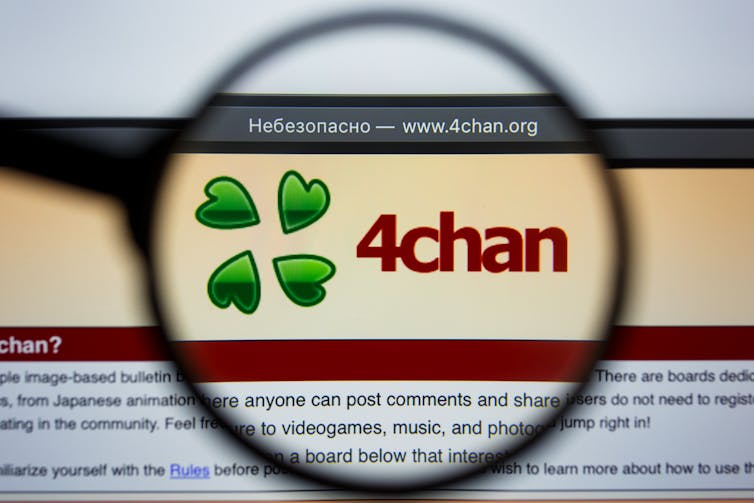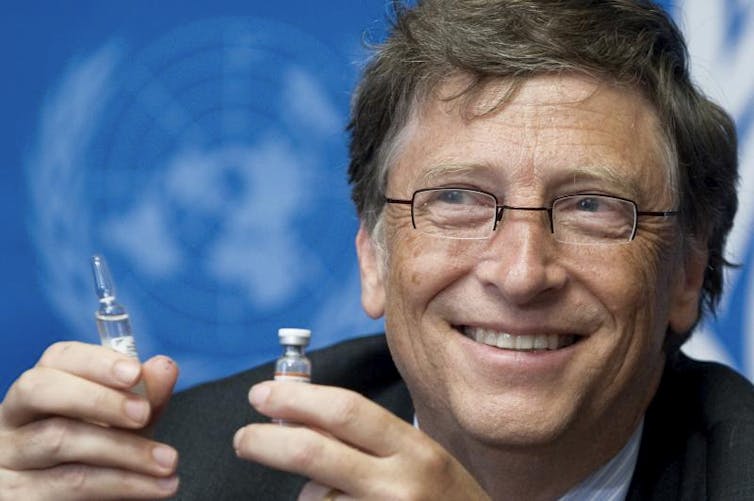from The Conversation
— this post authored by Jan Buts, Trinity College Dublin
For most of us, memes are the harmless fodder of an “extremely online” internet culture, floating benignly between different social media platforms – and, on the whole, making us laugh. But in the shadier corners of the internet, like on the forum 4chan, memes can quickly mutate from jokes into more ambiguous, shocking and potentially harmful viral content.

Please share this article – Go to very top of page, right hand side, for social media buttons.
That’s especially true of memes that call into question the efficacy and safety of vaccines – often termed “anti-vax” content. Anti-vaccination sentiment is not a new phenomenon, but is increasingly fuelled by online misinformation. Unfounded claims proliferate online, linking vaccines to disease development, or presenting COVID-19 as a hoax.
When they go viral, such conspiracy theories present a major obstacle to the success of any immunisation campaign, as they may contribute to vaccine hesitancy. In the UK, more than a quarter of the population signals reluctance or suspicion about receiving the COVID-19 vaccine. Globally, willingness to be vaccinated varies widely.
To combat the spread of anti-vaccination rumours, platforms are currently using a dual strategy of censorship and fact checking. Both practices have their pitfalls. Censorship may actually stimulate curiosity, while people who distrust mainstream media are not likely to trust fact checkers.
And much online content – like viral memes – is not primarily meant to inform, and is therefore hard to evaluate in terms of whether it’s information, misinformation, or simply a joke.
Imageboard dissidence
Internet memes are a defining feature of online communication. The term can refer to any widely shared and replicated piece of online content in a variety of styles and formats. While mostly humorous or relatable, some memes have come to be associated with hateful beliefs through their occurrence on influential websites such as the imageboard 4chan.
Read more: Coronavirus and conspiracies: how the far right is exploiting the pandemic
4chan boasts over 20 million unique visitors a month, and is highly influential in meme culture. On 4chan’s “Politically Incorrect” board (/pol/), people anonymously discuss world news and political events from perspectives that run counter to the public consensus. Views expressed on /pol/ can be shocking and unpleasant.
Conspiracy theories such as QAnon flourished on /pol/, and the forum has been linked to the recent Capitol riots.

4chan is an imageboard from which many famous memes have originated. II.studio/Shutterstock
Presumed malicious intent behind vaccination programmes is a commonly voiced concern on the board. In a recent study, I showed that anti-vaccination posts encountered on /pol/ (and found across social media) display a number of recurring elements, such as revulsion to vaccine ingredients and selective appeals to authority. With vaccine hesitancy becoming an increasingly pressing concern, the role of such memetic patterns in the spread of misinformation deserves careful attention.
Renegade quotes
Anti-vaccination posts regularly contain a visual component. For instance, a reference to authority can be expressed through a vaccine-critical quote next to the face of the person who supposedly uttered it. Surprisingly often, quotes included in anti-vaccination discussions are attributed incorrectly.
Online, incorrect attribution does not just happen by accident. Fake quotes are a very popular meme format, often intended to satirise and amuse. Today’s internet users are likely to encounter the face of historic figures such as Lincoln, Einstein or Gandhi, paired with an absurdly out-of-place statement.
Such memes creatively critique the popular practice of sharing inspirational messages. They also ridicule received sources of wisdom and authority. But as a result, it is often unclear whether anti-vaccination statements voiced through the face-and-quote format are shared and received in earnest, or through an ironic lens.

This image of Bill Gates with a vaccine has been repurposed hundreds of times online. Jean-Marc Ferré/UN Photo, CC BY-NC-ND
Accustomed to online irony, a proportion of internet users on 4chan and beyond may not intend their multi-layered jokes to contribute to vaccine hesitancy. The influence of ironic meme culture may also mitigate the impact of misinformation by priming the browsing crowd for absurdity rather than accuracy. However, diverse audiences make for diverse reactions. While quotes supposedly exposing the evil intentions of figures such as Bill Gates – a common target of conspiratorial beliefs – can easily be read in jest, they can also influence internet users to distrust vaccines.
Vaccine revolt
A second common feature of anti-vaccination discourse is revulsion to vaccine ingredients. This sentiment tends to be communicated by means of lists combining chemical and bestial elements. When taken out of context, a compilation of vaccine components – mentioning mercury, formaldehyde, and cow’s blood – can indeed inspire fear and disgust. When presented to shock, the ingredients of any complex product may come to look like an alchemist’s concoction or a sinister witch’s brew.
Feelings of aversion may be exacerbated by the image of a syringe, which in anti-vax posts is often presented together with ingredients deemed harmful. Most children fear needles, and a large proportion of adults do, too. In many contexts, sharp objects are associated with harm, not health.
It is surprising, then, that ironic replications of the syringe-plus-ingredients template circulate online, mocking the anti-vaxxer’s fears and supposed scientific illiteracy. Such memetic efforts may aim to comically combat misinformation, but nonetheless spread visual prompts that reinforce suspicion. From this perspective, you may even wonder whether popular newspapers contribute to vaccine hesitancy by repeatedly using pictures of a needle breaching the skin.
Attitudes to vaccination are communicated not just through what is written, but also through particular representational patterns. Meme formats and visual outlines can spread misinformation, even when created and shared with humorous intent.
After all, “Poe’s Law” dictates that there’s a wafer-thin line between satirical and fanatical content. In the context of COVID-19, that line is all too easily crossed.
Jan Buts, Postdoctoral Research Fellow, Translation Studies, Trinity College Dublin
This article is republished from The Conversation under a Creative Commons license. Read the original article.
.








